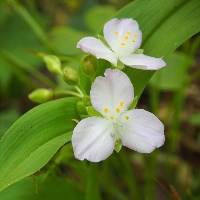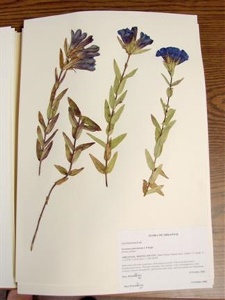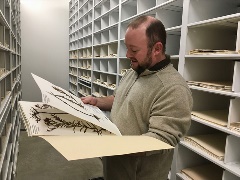Native Gardening Guide
WHAT ARE NATIVE PLANTS?
A native plant is one that occurs naturally in a particular region, ecosystem, or habitat without direct or indirect human intervention. The plants present prior to statehood are considered native to Arkansas.
ANHC's GUIDE TO NATIVE PLANTS FOR ARKANSAS GARDENS
Our botanists have put together a list of plants native to large portions of Arkansas that should do well on sites with the appropriate amount of sun and moisture. To learn more about using native plants, download our Native Plants for Arkansas Gardens guide.
The Atlas of the Vascular Plants of Arkansas
Though published nearly 10 years ago, the Atlas remains the most complete accounting of the county-level distribution of the state's native and non-native vascular plants. Published by the University of Arkansas Herbarium in 2013 as a 709-page softcover
book, the Atlas is now available as a searchable PDF file. Click below for a free download of the full-size version (22.3 MB), best for printing or viewing on a desktop or laptop computer or the reduced file-size version (12.4 MB), more suitable for
viewing on a smartphone or tablet.
NATIVE PLANTS ARE A GOOD GARDENING CHOICE
Arkansas’s native plants are uniquely adapted to live with our soils, climate, and wildlife.
What are some benefits of using native plants in your garden?
- Save Water – Once established, many Arkansas native plants need minimal irrigation beyond normal rainfall, saving our valuable water resources and money too.
- Lower Maintenance – Native plants do best with some attention and care, but require less water, fertilizer, pruning, fewer or no pesticides, and less of your time to maintain.
- Reduce Chemicals – Native plants have developed their own defenses against pests and diseases. Since most pesticides kill indiscriminately, beneficial insects become secondary targets in the fight against pests. Reducing or eliminating pesticide use lets natural control take over and keeps chemical out of our creeks and watersheds. Invite Wildlife – Birds, butterflies, and other beneficial insects all prefer native plants and many actually depend on them for stages of their life cycle. Help Arkansas pollinators and they will return the favor by setting more fruit in your garden while other wildlife will keep your landscape free of mosquitoes and plant-eating bugs.
- Support Local Ecology – While creating native gardens will never replace all the lost natural habitats, planting yards, parks, and roadsides with native plants can help provide an important bridge to nearby remaining wild areas. Recommend native plants to homeowner associations, neighbors, and other local land-use planning opportunities.
- Reduce Invasive Species – Gardening with native plants helps lessen the introduction and spread of invasive species. Many of the invasive species we struggle with today were intentionally introduced as gardening plants. The same characteristics that make a low-maintenance garden plant – hardy, fast-growing, and easy to care for – often allow that plant to grow in natural areas and replace native vegetation. Check the contents of “wildflower” seed mixes carefully; many species in these mixes may not be Arkansas natives.
- A Sense of Place – Native plant gardens maintain a sense of place. Buying the same commercial nursery plants no matter where you live might be easy, but gardens all over the country end up looking exactly the same. Native plants allow you to appreciate the unique landscape of your area.
The blog post "Some Native Gardening Basics I Learned the Hard Way" by ANHC Chief of Research, Theo Witsell, provides additional guidance on gardening with native plants.
Can I Dig Up Native Plants in the Wild?
Digging up native plants causes several problems:
- It reduces the natural population and consequently reduces the diversity within that population
- Nature is likely to "fill the vacuum" you create when you dig up plants with different species, often invasive ones
- Wild-collected plants usually do not perform as well in a garden as those propagated in a nursery or grown from seeds or cuttings.
ANHC Herbarium
A herbarium, like a library, is a collection of preserved plants that are stored, cataloged, and arranged systematically for study. The ANHC maintains one of eight herbaria in the state recognized by the Index Herbariorum (IH), the official database of worldwide herbaria. The herbarium at the ANHC has been recognized by the IH since 2003 and it currently contains more than 15,000 specimens. The oldest specimen in the herbarium, Slender Rose-gentian (Sabatia campanulata), was collected in 1941 by Delzie Demaree.
LEARN MORE ABOUT NATIVE PLANTS AND GARDENING
- Arkansas Native Plant Society
The Society promotes 1) the preservation, conservation, study, and enjoyment of the native plants of Arkansas, 2) the education of the public regarding the value of native plants and their habitats, and 3) the publication of related information, including the new Atlas of the Vascular Plants of Arkansas. Visit their website to purchase a copy and to find more information about local native plant suppliers. - Arkansas Wild Spaces (AWS), a non-profit subsidiary of Central Arkansas Master Naturalists
Arkansas Wild Spaces sends volunteers to visit yards and teach homeowners how to make their yards more wildlife friendly, particularly for birds, butterflies and bees. After a 2-hour visit, volunteers write and send a report to the homeowner summarizing the recommendations and comparing the status of the yard to AWS certification standards. The service is only available in Pulaski, Jefferson, Lonoke and parts of Saline counties. For more information and a fee schedule, visit the AWS website. - Audubon Arkansas - Native Plants for Birds and Butterflies
This site includes a downloadable database of native plants. - Wild Ones: Native Plants, Natural Landscapes, Ozark Chapter
A volunteer non-profit that promotes environmentally sound landscaping practices to preserve biodiversity through the preservation, restoration, and establishment of native plant communities. They provide 1) free educational resources on how to incorporate native plants into gardens and landscapes, including a quarterly journal, 2) educational workshops, 3) landscaping design services and volunteer labor to municipalities for rain garden and other native plant gardening projects, and 4) free consulting services to Arkansas residents on how to incorporate native plants into their gardens. - Invasive Plant Species FAQ
- Invasive Plant Species Found in Arkansas
- Lady Bird Johnson Wildflower Center - Arkansas Recommended
- ANHC Native Plant Photo Gallery
RESOURCES FOR A SCHOOLYARD GARDEN
Activities and information about how a schoolyard garden can be used across the curriculum and benefit all students.


